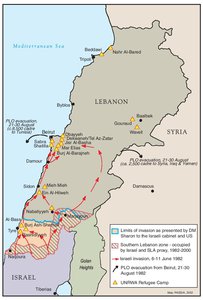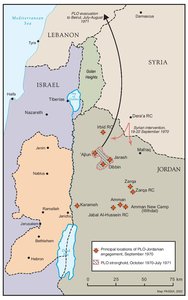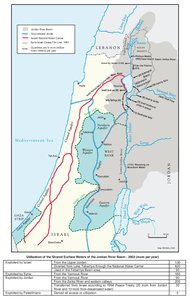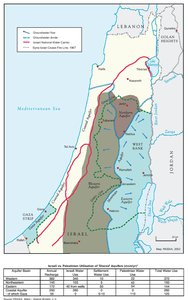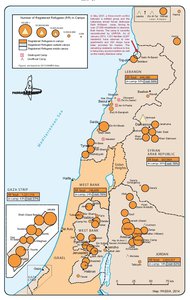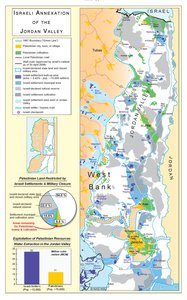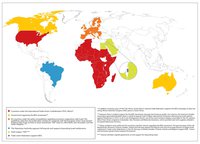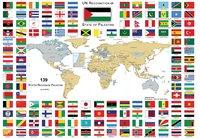LEBANON, 1982
Map Details
After establishing its new headquarters in Lebanon, the PLO set about forging alliances with local forces
and rearming its units. Once again a Palestinian ‘mini-state’ emerged, with its own welfare, commercial and
other administrative functions.
By 1975, Israeli counter-offensives against guerillas in the south had caused the dislocation of thousands of
Lebanese civilians. Insecurities among the Christian Maronite leaders, who recognized a challenge to their
status in the PLO para-state’s alliances with local Muslims, were exacerbating sectarian tensions. A bitter
and complex civil war erupted in April 1975, lasting 18 months and leaving at least 20,000 dead, most of
them civilians. Towards the end of the war, Israeli Prime Minister Rabin initiated an alliance with the PLO’s
main adversaries, the Maronite Phalange, a large militia with ideological roots in Nazism. By the end of the
war, Israel had also created a ‘proxy’ force in southern Lebanon, headed by Sa’ad Haddad. From late
1976, the PLO and Haddad’s forces vied inconclusively for control of the southern sector. Israel retaliated
for a March 1978 PLO raid on Israel by invading the south, killing some 2,000 and displacing 250,000
civilians. Thereafter, unprovoked Israeli offensives in the south and bombing raids on Beirut persisted,
despite US pressure applied in July 1981.
In December 1981, Defense Minister Ariel Sharon presented the Israeli cabinet and the US with his ‘Big
Plan’ to “wipe them [the PLO] out completely in Lebanon.” Begin’s cabinet was concerned but endorsed a
version of the plan. US envoy Philip Habib was shocked though, and told Sharon: “[Y]ou can’t go around
invading countries like that, spreading destruction and killing civilians!” But US Secretary of State Haig
ceded tentatively, provided the assault followed “internationally recognized provocation.”
The failed assassination of Shlomo Argov, Israel’s ambassador to the UK, carried out by anti-PLO Abu
Nidal forces on 3 June, eventually provided Israel with the pretext it needed. On 6 June, a massive Israeli
force invaded Lebanon. Within a week Defense Minister Sharon had broken every assurance he had
offered the US and his own Prime Minister, and rather than holding a 40-km ‘buffer’ in the south (the
declared operational objective), the Israeli army was laying siege to Beirut. A 11 June US-sponsored ceasefire
was brushed aside, as Sharon ordered his troops and their Phalange allies into the capital’s residential
quarters. Last minute US threats of intervention stalled the advance and allowed US envoy Habib to
negotiate an evacuation of the PLO forces holding out in the capital. After a two-month siege, the PLO
agreed to ‘evacuation without surrender’ in return for US guarantees for a multinational protection force to
ensure the safety of Beirut’s Palestinian civilians.
On 21 August, the US 6th Fleet escorted the first contingent of PLO forces out to sea, bound for Tunis via
Greece. On 30 August, Arafat left Beirut after an 11-year stay. In all, some 8,500 PLO cadre left by sea and
a further 2,500 by land (to Syria, Yemen and Iraq). The Israelis, with US assistance, had in the meantime
successfully installed their Phalange ally, Bashir Gemayal, as president on 23 August. His assassination
three weeks later fouled Israel’s long-term Lebanon strategy, calling for a pliant Christian buffer-state ruled
by a military client, and led to the most horrific incident of the war.
Prior to evacuation, the PLO had demanded, and been given, “the assurances of the United States as
regards safety and security... for the [refugee] camps in Beirut.” But following PLO withdrawal, the US-led
multinational force charged with this undertaking was inexplicably pulled out well ahead of the agreed
schedule, leaving the Palestinians at the mercy of Israel and its Phalange allies. On 16 September, Israel
sealed the Sabra and Shatila RCs, positioned tanks around their entrances and ordered their Haddad
forces as well as the Phalange militia to “purify the area,” in an operation approved by Defense Minister
Sharon himself. Up to 3,000 men, women and children were then mutilated, raped and murdered in a 42-
hour massacre presided over by the Israeli army, whose flares lit up the camps during the night hours.
Though Israel would later shift responsibility for the atrocities onto its allies, US officials noted at the time
that regardless of Israel’s functional involvement in the killings, it was “…in absolute control of the area and
therefore responsible.”
Israel’s ‘Peace for Galilee’ operation cost it 446 lives. At the very least, 21,000 Palestinians and Lebanese
were killed during the fighting (and many more died later as a result of their injuries or unexploded
ordinance). Some 84% of the dead were Arab civilians; 600,000 Lebanese and Palestinians were rendered
homeless. On 17 May 1983, Israel and Lebanon signed a cease-fire agreement and ended the war, but
Israel was to remain - with its militia - in southern Lebanon for another 17 years.

